Case Study Response: Dora's Care, Ethical Issues, and Policies
VerifiedAdded on 2020/10/05
|12
|3068
|356
Case Study
AI Summary
This case study examines the ethical and practical challenges surrounding the care of Dora, a blind woman diagnosed with Alzheimer's, and the impact of her permanent placement in a nursing home. The assignment analyzes the case through the lens of legislative frameworks, ethical principles, and the experiences of Dora and her husband, Simon. It explores the effects of stigmatization, stereotyping, and discrimination by healthcare professionals, highlighting violations of ethical standards and human rights. The discussion delves into the importance of understanding legislative measures, promoting anti-oppressive practices, and challenging inequalities in healthcare. The analysis underscores the need for empathy, sensitivity, and the implementation of ethical codes of conduct to ensure that individuals like Dora receive dignified and appropriate care, emphasizing the significance of family involvement and the prevention of hasty decisions based on prejudiced notions. The conclusion recommends the integration of ethical standards, the discouragement of stereotyping, and the establishment of supportive networks to improve care for individuals with disabilities.
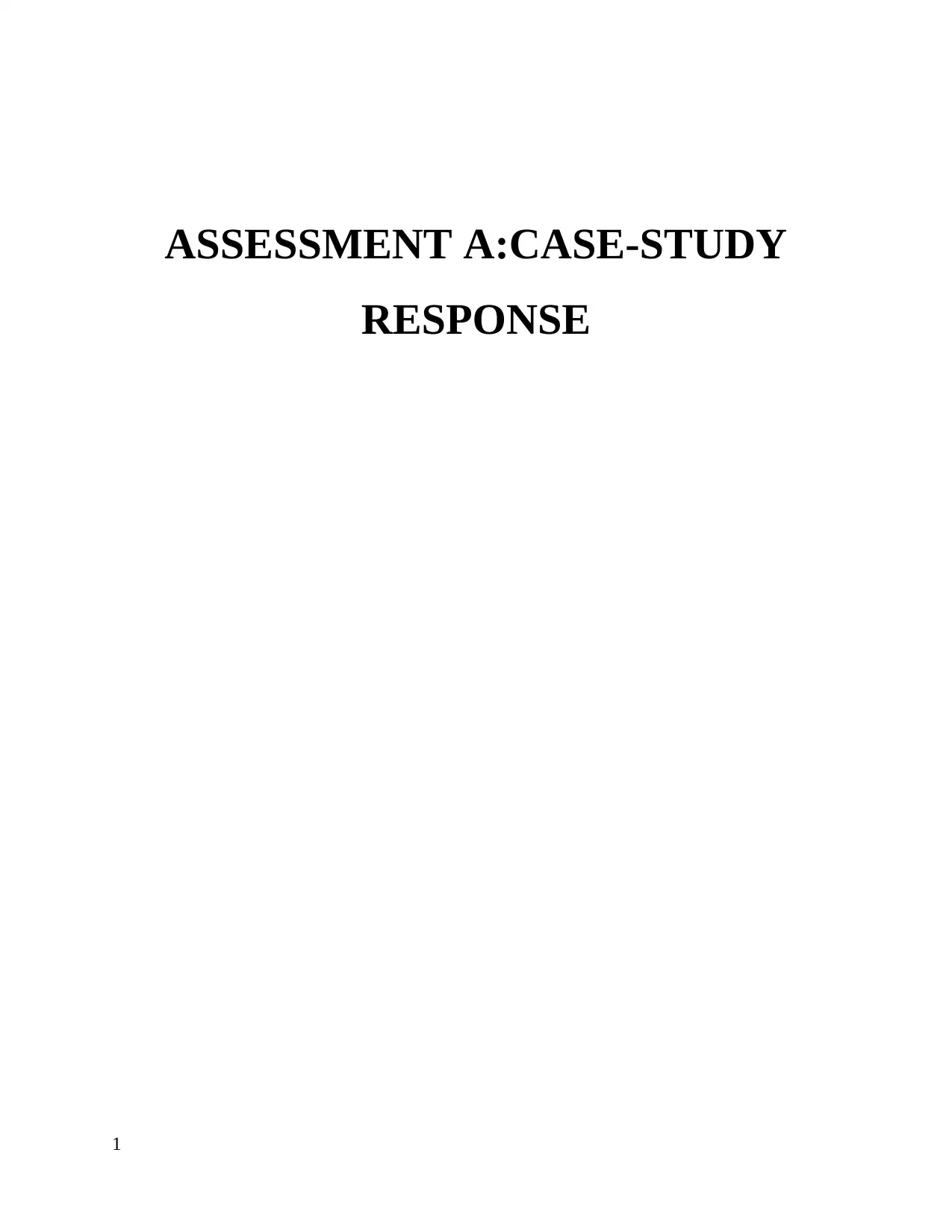
ASSESSMENT A:CASE-STUDY
RESPONSE
1
RESPONSE
1
Paraphrase This Document
Need a fresh take? Get an instant paraphrase of this document with our AI Paraphraser
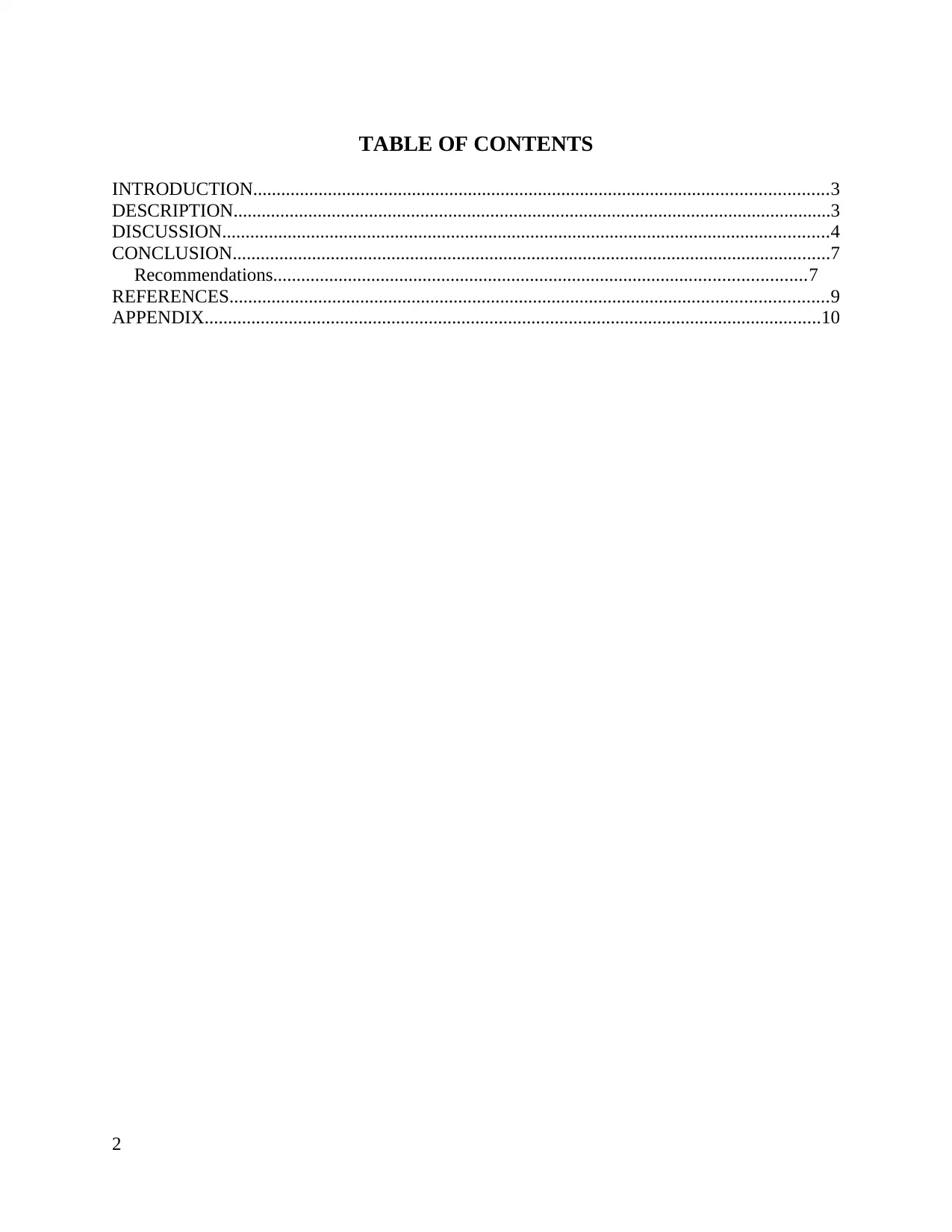
TABLE OF CONTENTS
INTRODUCTION...........................................................................................................................3
DESCRIPTION................................................................................................................................3
DISCUSSION..................................................................................................................................4
CONCLUSION................................................................................................................................7
Recommendations..................................................................................................................7
REFERENCES................................................................................................................................9
APPENDIX....................................................................................................................................10
2
INTRODUCTION...........................................................................................................................3
DESCRIPTION................................................................................................................................3
DISCUSSION..................................................................................................................................4
CONCLUSION................................................................................................................................7
Recommendations..................................................................................................................7
REFERENCES................................................................................................................................9
APPENDIX....................................................................................................................................10
2
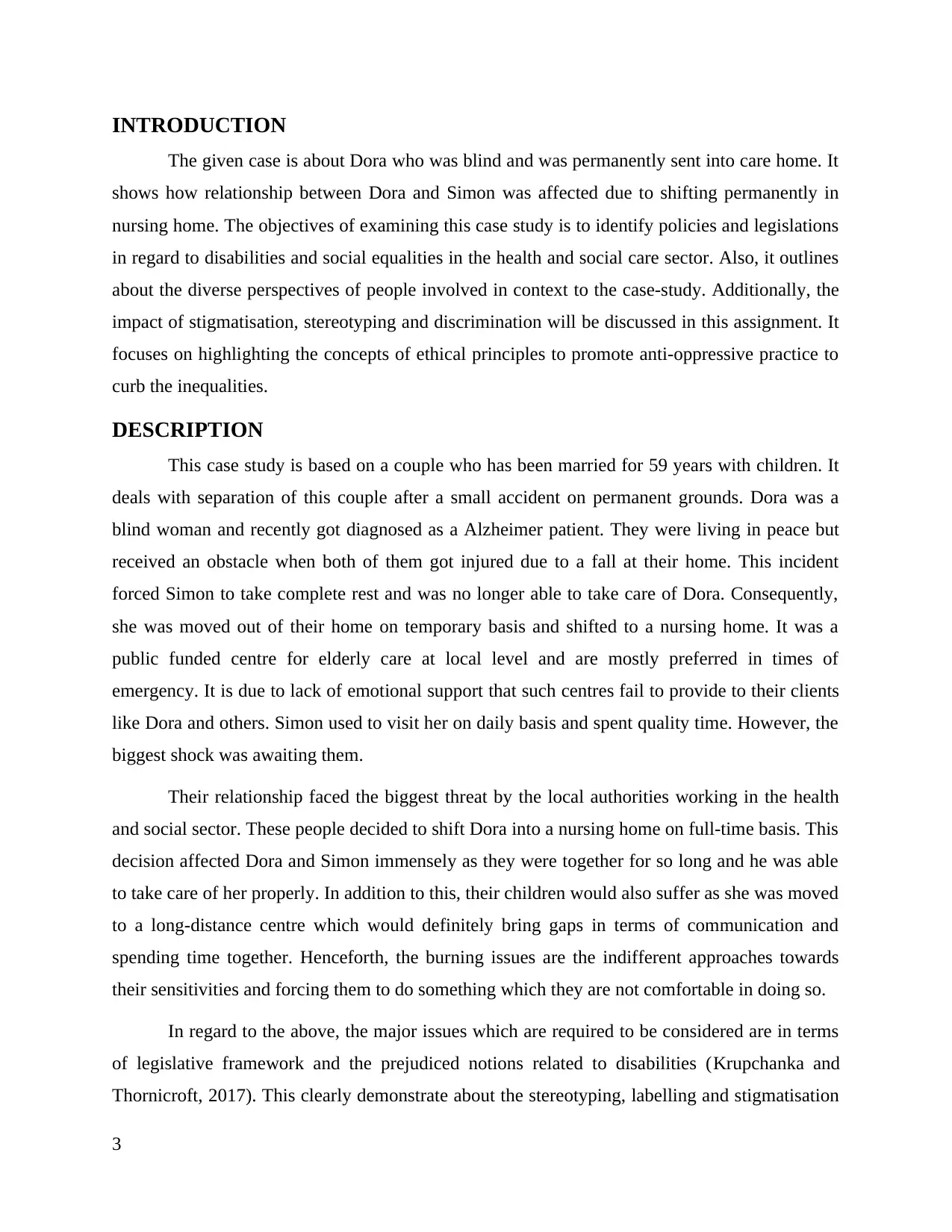
INTRODUCTION
The given case is about Dora who was blind and was permanently sent into care home. It
shows how relationship between Dora and Simon was affected due to shifting permanently in
nursing home. The objectives of examining this case study is to identify policies and legislations
in regard to disabilities and social equalities in the health and social care sector. Also, it outlines
about the diverse perspectives of people involved in context to the case-study. Additionally, the
impact of stigmatisation, stereotyping and discrimination will be discussed in this assignment. It
focuses on highlighting the concepts of ethical principles to promote anti-oppressive practice to
curb the inequalities.
DESCRIPTION
This case study is based on a couple who has been married for 59 years with children. It
deals with separation of this couple after a small accident on permanent grounds. Dora was a
blind woman and recently got diagnosed as a Alzheimer patient. They were living in peace but
received an obstacle when both of them got injured due to a fall at their home. This incident
forced Simon to take complete rest and was no longer able to take care of Dora. Consequently,
she was moved out of their home on temporary basis and shifted to a nursing home. It was a
public funded centre for elderly care at local level and are mostly preferred in times of
emergency. It is due to lack of emotional support that such centres fail to provide to their clients
like Dora and others. Simon used to visit her on daily basis and spent quality time. However, the
biggest shock was awaiting them.
Their relationship faced the biggest threat by the local authorities working in the health
and social sector. These people decided to shift Dora into a nursing home on full-time basis. This
decision affected Dora and Simon immensely as they were together for so long and he was able
to take care of her properly. In addition to this, their children would also suffer as she was moved
to a long-distance centre which would definitely bring gaps in terms of communication and
spending time together. Henceforth, the burning issues are the indifferent approaches towards
their sensitivities and forcing them to do something which they are not comfortable in doing so.
In regard to the above, the major issues which are required to be considered are in terms
of legislative framework and the prejudiced notions related to disabilities (Krupchanka and
Thornicroft, 2017). This clearly demonstrate about the stereotyping, labelling and stigmatisation
3
The given case is about Dora who was blind and was permanently sent into care home. It
shows how relationship between Dora and Simon was affected due to shifting permanently in
nursing home. The objectives of examining this case study is to identify policies and legislations
in regard to disabilities and social equalities in the health and social care sector. Also, it outlines
about the diverse perspectives of people involved in context to the case-study. Additionally, the
impact of stigmatisation, stereotyping and discrimination will be discussed in this assignment. It
focuses on highlighting the concepts of ethical principles to promote anti-oppressive practice to
curb the inequalities.
DESCRIPTION
This case study is based on a couple who has been married for 59 years with children. It
deals with separation of this couple after a small accident on permanent grounds. Dora was a
blind woman and recently got diagnosed as a Alzheimer patient. They were living in peace but
received an obstacle when both of them got injured due to a fall at their home. This incident
forced Simon to take complete rest and was no longer able to take care of Dora. Consequently,
she was moved out of their home on temporary basis and shifted to a nursing home. It was a
public funded centre for elderly care at local level and are mostly preferred in times of
emergency. It is due to lack of emotional support that such centres fail to provide to their clients
like Dora and others. Simon used to visit her on daily basis and spent quality time. However, the
biggest shock was awaiting them.
Their relationship faced the biggest threat by the local authorities working in the health
and social sector. These people decided to shift Dora into a nursing home on full-time basis. This
decision affected Dora and Simon immensely as they were together for so long and he was able
to take care of her properly. In addition to this, their children would also suffer as she was moved
to a long-distance centre which would definitely bring gaps in terms of communication and
spending time together. Henceforth, the burning issues are the indifferent approaches towards
their sensitivities and forcing them to do something which they are not comfortable in doing so.
In regard to the above, the major issues which are required to be considered are in terms
of legislative framework and the prejudiced notions related to disabilities (Krupchanka and
Thornicroft, 2017). This clearly demonstrate about the stereotyping, labelling and stigmatisation
3
⊘ This is a preview!⊘
Do you want full access?
Subscribe today to unlock all pages.

Trusted by 1+ million students worldwide
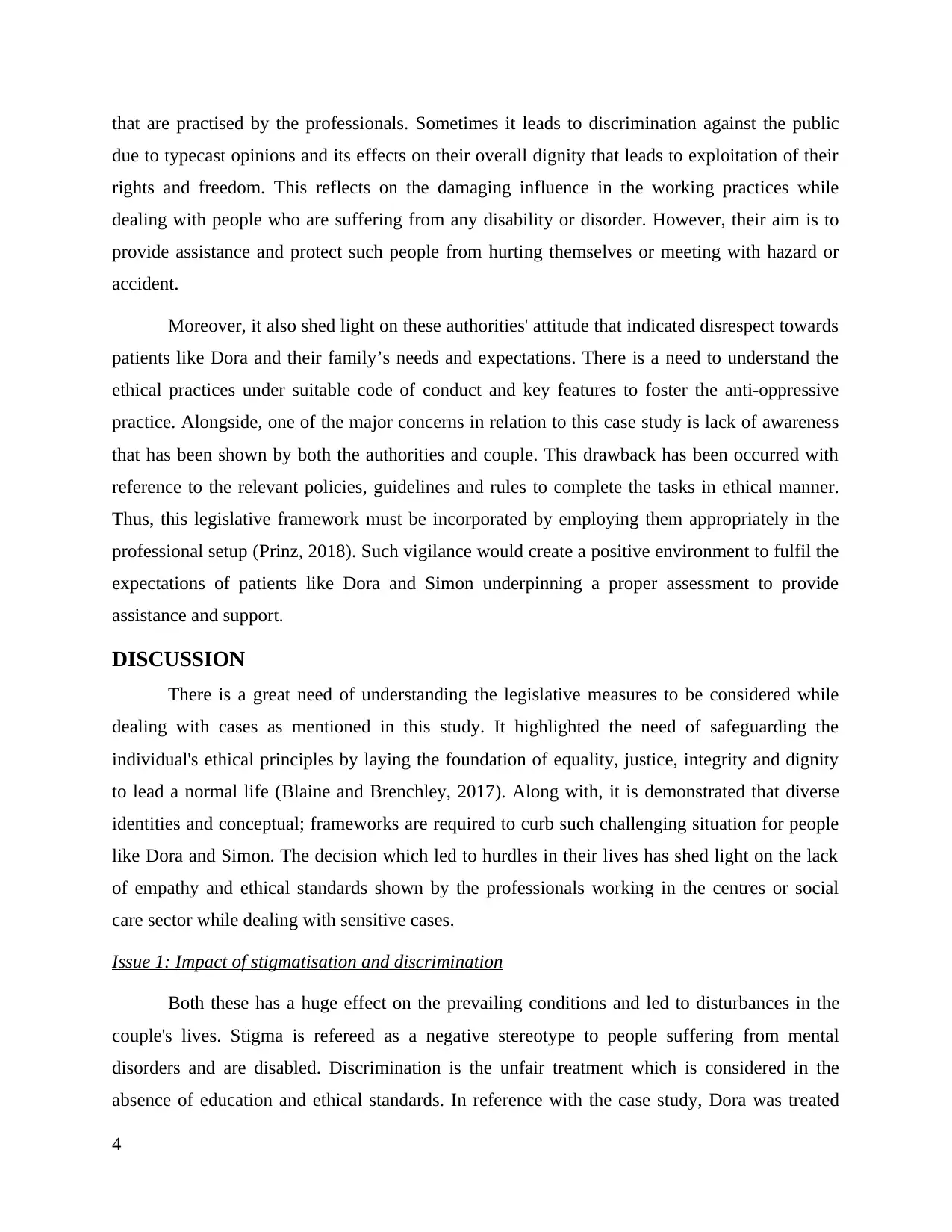
that are practised by the professionals. Sometimes it leads to discrimination against the public
due to typecast opinions and its effects on their overall dignity that leads to exploitation of their
rights and freedom. This reflects on the damaging influence in the working practices while
dealing with people who are suffering from any disability or disorder. However, their aim is to
provide assistance and protect such people from hurting themselves or meeting with hazard or
accident.
Moreover, it also shed light on these authorities' attitude that indicated disrespect towards
patients like Dora and their family’s needs and expectations. There is a need to understand the
ethical practices under suitable code of conduct and key features to foster the anti-oppressive
practice. Alongside, one of the major concerns in relation to this case study is lack of awareness
that has been shown by both the authorities and couple. This drawback has been occurred with
reference to the relevant policies, guidelines and rules to complete the tasks in ethical manner.
Thus, this legislative framework must be incorporated by employing them appropriately in the
professional setup (Prinz, 2018). Such vigilance would create a positive environment to fulfil the
expectations of patients like Dora and Simon underpinning a proper assessment to provide
assistance and support.
DISCUSSION
There is a great need of understanding the legislative measures to be considered while
dealing with cases as mentioned in this study. It highlighted the need of safeguarding the
individual's ethical principles by laying the foundation of equality, justice, integrity and dignity
to lead a normal life (Blaine and Brenchley, 2017). Along with, it is demonstrated that diverse
identities and conceptual; frameworks are required to curb such challenging situation for people
like Dora and Simon. The decision which led to hurdles in their lives has shed light on the lack
of empathy and ethical standards shown by the professionals working in the centres or social
care sector while dealing with sensitive cases.
Issue 1: Impact of stigmatisation and discrimination
Both these has a huge effect on the prevailing conditions and led to disturbances in the
couple's lives. Stigma is refereed as a negative stereotype to people suffering from mental
disorders and are disabled. Discrimination is the unfair treatment which is considered in the
absence of education and ethical standards. In reference with the case study, Dora was treated
4
due to typecast opinions and its effects on their overall dignity that leads to exploitation of their
rights and freedom. This reflects on the damaging influence in the working practices while
dealing with people who are suffering from any disability or disorder. However, their aim is to
provide assistance and protect such people from hurting themselves or meeting with hazard or
accident.
Moreover, it also shed light on these authorities' attitude that indicated disrespect towards
patients like Dora and their family’s needs and expectations. There is a need to understand the
ethical practices under suitable code of conduct and key features to foster the anti-oppressive
practice. Alongside, one of the major concerns in relation to this case study is lack of awareness
that has been shown by both the authorities and couple. This drawback has been occurred with
reference to the relevant policies, guidelines and rules to complete the tasks in ethical manner.
Thus, this legislative framework must be incorporated by employing them appropriately in the
professional setup (Prinz, 2018). Such vigilance would create a positive environment to fulfil the
expectations of patients like Dora and Simon underpinning a proper assessment to provide
assistance and support.
DISCUSSION
There is a great need of understanding the legislative measures to be considered while
dealing with cases as mentioned in this study. It highlighted the need of safeguarding the
individual's ethical principles by laying the foundation of equality, justice, integrity and dignity
to lead a normal life (Blaine and Brenchley, 2017). Along with, it is demonstrated that diverse
identities and conceptual; frameworks are required to curb such challenging situation for people
like Dora and Simon. The decision which led to hurdles in their lives has shed light on the lack
of empathy and ethical standards shown by the professionals working in the centres or social
care sector while dealing with sensitive cases.
Issue 1: Impact of stigmatisation and discrimination
Both these has a huge effect on the prevailing conditions and led to disturbances in the
couple's lives. Stigma is refereed as a negative stereotype to people suffering from mental
disorders and are disabled. Discrimination is the unfair treatment which is considered in the
absence of education and ethical standards. In reference with the case study, Dora was treated
4
Paraphrase This Document
Need a fresh take? Get an instant paraphrase of this document with our AI Paraphraser
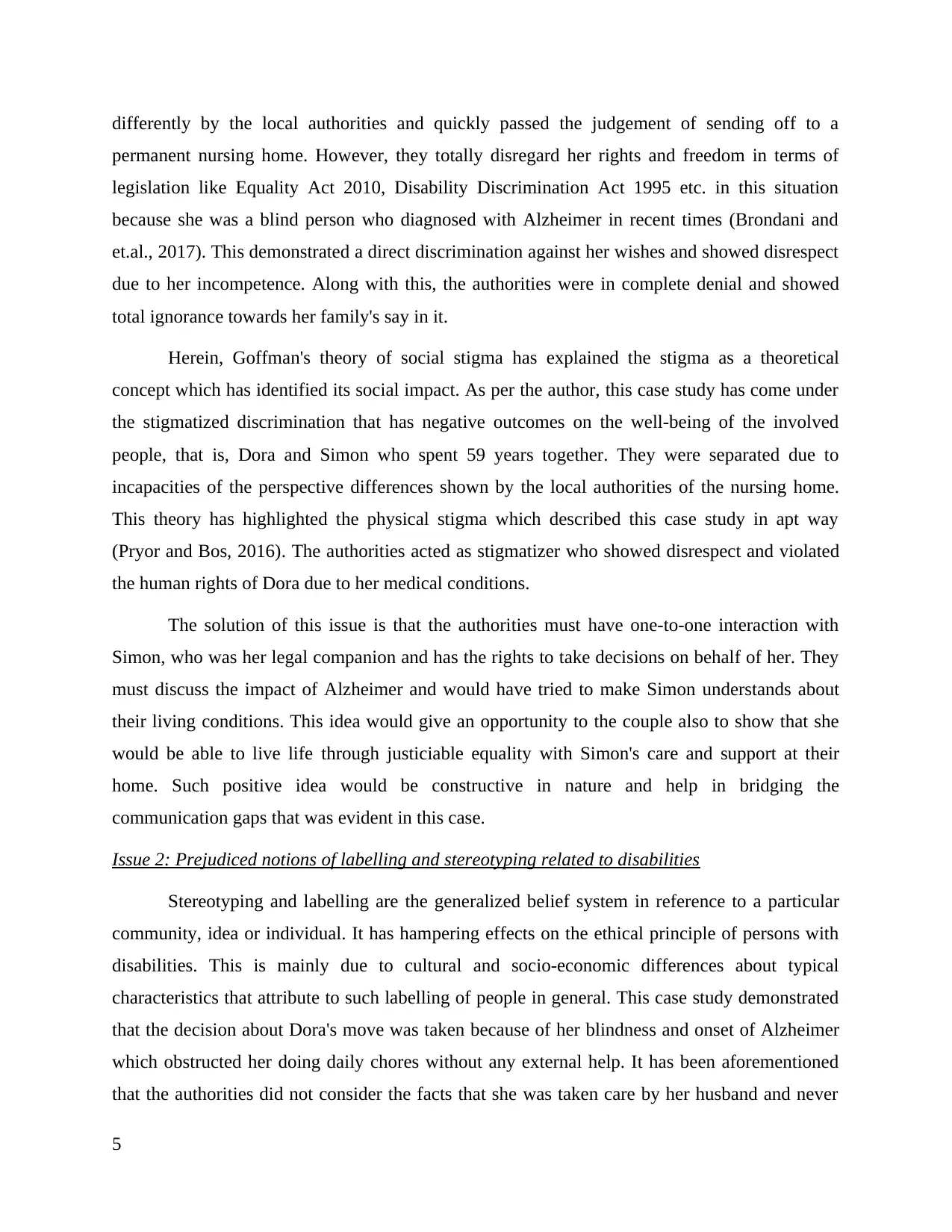
differently by the local authorities and quickly passed the judgement of sending off to a
permanent nursing home. However, they totally disregard her rights and freedom in terms of
legislation like Equality Act 2010, Disability Discrimination Act 1995 etc. in this situation
because she was a blind person who diagnosed with Alzheimer in recent times (Brondani and
et.al., 2017). This demonstrated a direct discrimination against her wishes and showed disrespect
due to her incompetence. Along with this, the authorities were in complete denial and showed
total ignorance towards her family's say in it.
Herein, Goffman's theory of social stigma has explained the stigma as a theoretical
concept which has identified its social impact. As per the author, this case study has come under
the stigmatized discrimination that has negative outcomes on the well-being of the involved
people, that is, Dora and Simon who spent 59 years together. They were separated due to
incapacities of the perspective differences shown by the local authorities of the nursing home.
This theory has highlighted the physical stigma which described this case study in apt way
(Pryor and Bos, 2016). The authorities acted as stigmatizer who showed disrespect and violated
the human rights of Dora due to her medical conditions.
The solution of this issue is that the authorities must have one-to-one interaction with
Simon, who was her legal companion and has the rights to take decisions on behalf of her. They
must discuss the impact of Alzheimer and would have tried to make Simon understands about
their living conditions. This idea would give an opportunity to the couple also to show that she
would be able to live life through justiciable equality with Simon's care and support at their
home. Such positive idea would be constructive in nature and help in bridging the
communication gaps that was evident in this case.
Issue 2: Prejudiced notions of labelling and stereotyping related to disabilities
Stereotyping and labelling are the generalized belief system in reference to a particular
community, idea or individual. It has hampering effects on the ethical principle of persons with
disabilities. This is mainly due to cultural and socio-economic differences about typical
characteristics that attribute to such labelling of people in general. This case study demonstrated
that the decision about Dora's move was taken because of her blindness and onset of Alzheimer
which obstructed her doing daily chores without any external help. It has been aforementioned
that the authorities did not consider the facts that she was taken care by her husband and never
5
permanent nursing home. However, they totally disregard her rights and freedom in terms of
legislation like Equality Act 2010, Disability Discrimination Act 1995 etc. in this situation
because she was a blind person who diagnosed with Alzheimer in recent times (Brondani and
et.al., 2017). This demonstrated a direct discrimination against her wishes and showed disrespect
due to her incompetence. Along with this, the authorities were in complete denial and showed
total ignorance towards her family's say in it.
Herein, Goffman's theory of social stigma has explained the stigma as a theoretical
concept which has identified its social impact. As per the author, this case study has come under
the stigmatized discrimination that has negative outcomes on the well-being of the involved
people, that is, Dora and Simon who spent 59 years together. They were separated due to
incapacities of the perspective differences shown by the local authorities of the nursing home.
This theory has highlighted the physical stigma which described this case study in apt way
(Pryor and Bos, 2016). The authorities acted as stigmatizer who showed disrespect and violated
the human rights of Dora due to her medical conditions.
The solution of this issue is that the authorities must have one-to-one interaction with
Simon, who was her legal companion and has the rights to take decisions on behalf of her. They
must discuss the impact of Alzheimer and would have tried to make Simon understands about
their living conditions. This idea would give an opportunity to the couple also to show that she
would be able to live life through justiciable equality with Simon's care and support at their
home. Such positive idea would be constructive in nature and help in bridging the
communication gaps that was evident in this case.
Issue 2: Prejudiced notions of labelling and stereotyping related to disabilities
Stereotyping and labelling are the generalized belief system in reference to a particular
community, idea or individual. It has hampering effects on the ethical principle of persons with
disabilities. This is mainly due to cultural and socio-economic differences about typical
characteristics that attribute to such labelling of people in general. This case study demonstrated
that the decision about Dora's move was taken because of her blindness and onset of Alzheimer
which obstructed her doing daily chores without any external help. It has been aforementioned
that the authorities did not consider the facts that she was taken care by her husband and never
5

went to nursing home. The nature of this situation was emergency and she went to centre on
temporary basis. After evaluating this case, few legislations such as The Regulation of Lunacy
(Ireland) Act 1871, Human Rights Act 1998, Article 19 of UN Convention for CRPD (Rights of
Persons with Disabilities) have been violated by these authorities and must be prohibited by them
to exercise it in the future.
Additionally, Labelling theory laid the platform to accept the approaches at societal level
to understand the role of professionals in the development of deviated behaviour towards the
people with disabilities (Matsueda, 2017). It emphasized on the idea of deviance as a relative
term and can be linked with the situation mentioned in the case study. This self-concept of
generating social label on the criteria of traits, profession or any exclusive attribute and thus this
theory is named a societal reaction theory. Dora and Simon were labelled by the authorities and
took decision about their lives without their consensus. They even did not bother to have a
discussion with them and is clear violation of their freedom and lack empathy and respect. They
hurt their self-esteem and totally disregard their desires, expectations and requirements.
Consequently, the solution would have been to impart proper training to the officials to
understand the causes, effects and overall analysis before making any decision or conclusion.
Moreover, the idea is to bring a sense of responsibility to maintain a dignified interactive
network with such patients to make positive changes for the betterment of the society on the
whole. Nonetheless, this solution can be evaluated through proper auditing and monitoring to
avoid such hasty decisions made by the professionals who sometimes overlook to the needs of
the patients and their families.
Issue 3: Professional role in promoting anti-oppressive practice and challenging inequalities
Anti-oppressive Practice is the interdisciplinary approach in social and healthcare sector
which concentrate on the oppression of people on basis of socio-economic factors and prevent
the occurrence of barriers while providing services. This approach has been lacking in
implementing part and thus there is a rise of social inequalities in terms of power, functionalities
and overall execution of rights. In regard to case study, Dora and Simon were victims of the
oppressive practises regulated by the local authorities who pushed their decisions on them. They
directly made the judgement of shifting her permanently to a nursing home situated at outskirts.
It highlighted the lack of understanding and clear violation of legislations like The United
6
temporary basis. After evaluating this case, few legislations such as The Regulation of Lunacy
(Ireland) Act 1871, Human Rights Act 1998, Article 19 of UN Convention for CRPD (Rights of
Persons with Disabilities) have been violated by these authorities and must be prohibited by them
to exercise it in the future.
Additionally, Labelling theory laid the platform to accept the approaches at societal level
to understand the role of professionals in the development of deviated behaviour towards the
people with disabilities (Matsueda, 2017). It emphasized on the idea of deviance as a relative
term and can be linked with the situation mentioned in the case study. This self-concept of
generating social label on the criteria of traits, profession or any exclusive attribute and thus this
theory is named a societal reaction theory. Dora and Simon were labelled by the authorities and
took decision about their lives without their consensus. They even did not bother to have a
discussion with them and is clear violation of their freedom and lack empathy and respect. They
hurt their self-esteem and totally disregard their desires, expectations and requirements.
Consequently, the solution would have been to impart proper training to the officials to
understand the causes, effects and overall analysis before making any decision or conclusion.
Moreover, the idea is to bring a sense of responsibility to maintain a dignified interactive
network with such patients to make positive changes for the betterment of the society on the
whole. Nonetheless, this solution can be evaluated through proper auditing and monitoring to
avoid such hasty decisions made by the professionals who sometimes overlook to the needs of
the patients and their families.
Issue 3: Professional role in promoting anti-oppressive practice and challenging inequalities
Anti-oppressive Practice is the interdisciplinary approach in social and healthcare sector
which concentrate on the oppression of people on basis of socio-economic factors and prevent
the occurrence of barriers while providing services. This approach has been lacking in
implementing part and thus there is a rise of social inequalities in terms of power, functionalities
and overall execution of rights. In regard to case study, Dora and Simon were victims of the
oppressive practises regulated by the local authorities who pushed their decisions on them. They
directly made the judgement of shifting her permanently to a nursing home situated at outskirts.
It highlighted the lack of understanding and clear violation of legislations like The United
6
⊘ This is a preview!⊘
Do you want full access?
Subscribe today to unlock all pages.

Trusted by 1+ million students worldwide
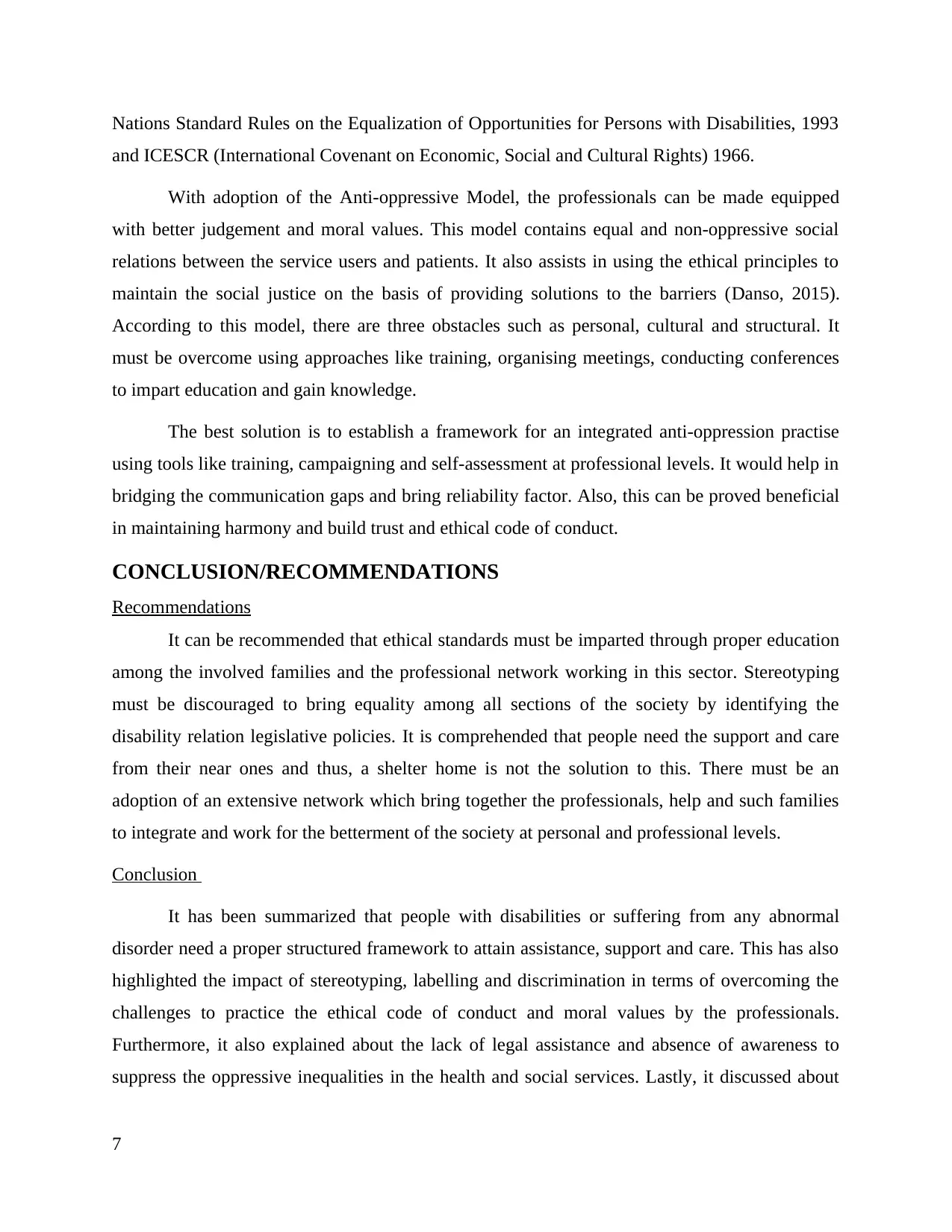
Nations Standard Rules on the Equalization of Opportunities for Persons with Disabilities, 1993
and ICESCR (International Covenant on Economic, Social and Cultural Rights) 1966.
With adoption of the Anti-oppressive Model, the professionals can be made equipped
with better judgement and moral values. This model contains equal and non-oppressive social
relations between the service users and patients. It also assists in using the ethical principles to
maintain the social justice on the basis of providing solutions to the barriers (Danso, 2015).
According to this model, there are three obstacles such as personal, cultural and structural. It
must be overcome using approaches like training, organising meetings, conducting conferences
to impart education and gain knowledge.
The best solution is to establish a framework for an integrated anti-oppression practise
using tools like training, campaigning and self-assessment at professional levels. It would help in
bridging the communication gaps and bring reliability factor. Also, this can be proved beneficial
in maintaining harmony and build trust and ethical code of conduct.
CONCLUSION/RECOMMENDATIONS
Recommendations
It can be recommended that ethical standards must be imparted through proper education
among the involved families and the professional network working in this sector. Stereotyping
must be discouraged to bring equality among all sections of the society by identifying the
disability relation legislative policies. It is comprehended that people need the support and care
from their near ones and thus, a shelter home is not the solution to this. There must be an
adoption of an extensive network which bring together the professionals, help and such families
to integrate and work for the betterment of the society at personal and professional levels.
Conclusion
It has been summarized that people with disabilities or suffering from any abnormal
disorder need a proper structured framework to attain assistance, support and care. This has also
highlighted the impact of stereotyping, labelling and discrimination in terms of overcoming the
challenges to practice the ethical code of conduct and moral values by the professionals.
Furthermore, it also explained about the lack of legal assistance and absence of awareness to
suppress the oppressive inequalities in the health and social services. Lastly, it discussed about
7
and ICESCR (International Covenant on Economic, Social and Cultural Rights) 1966.
With adoption of the Anti-oppressive Model, the professionals can be made equipped
with better judgement and moral values. This model contains equal and non-oppressive social
relations between the service users and patients. It also assists in using the ethical principles to
maintain the social justice on the basis of providing solutions to the barriers (Danso, 2015).
According to this model, there are three obstacles such as personal, cultural and structural. It
must be overcome using approaches like training, organising meetings, conducting conferences
to impart education and gain knowledge.
The best solution is to establish a framework for an integrated anti-oppression practise
using tools like training, campaigning and self-assessment at professional levels. It would help in
bridging the communication gaps and bring reliability factor. Also, this can be proved beneficial
in maintaining harmony and build trust and ethical code of conduct.
CONCLUSION/RECOMMENDATIONS
Recommendations
It can be recommended that ethical standards must be imparted through proper education
among the involved families and the professional network working in this sector. Stereotyping
must be discouraged to bring equality among all sections of the society by identifying the
disability relation legislative policies. It is comprehended that people need the support and care
from their near ones and thus, a shelter home is not the solution to this. There must be an
adoption of an extensive network which bring together the professionals, help and such families
to integrate and work for the betterment of the society at personal and professional levels.
Conclusion
It has been summarized that people with disabilities or suffering from any abnormal
disorder need a proper structured framework to attain assistance, support and care. This has also
highlighted the impact of stereotyping, labelling and discrimination in terms of overcoming the
challenges to practice the ethical code of conduct and moral values by the professionals.
Furthermore, it also explained about the lack of legal assistance and absence of awareness to
suppress the oppressive inequalities in the health and social services. Lastly, it discussed about
7
Paraphrase This Document
Need a fresh take? Get an instant paraphrase of this document with our AI Paraphraser
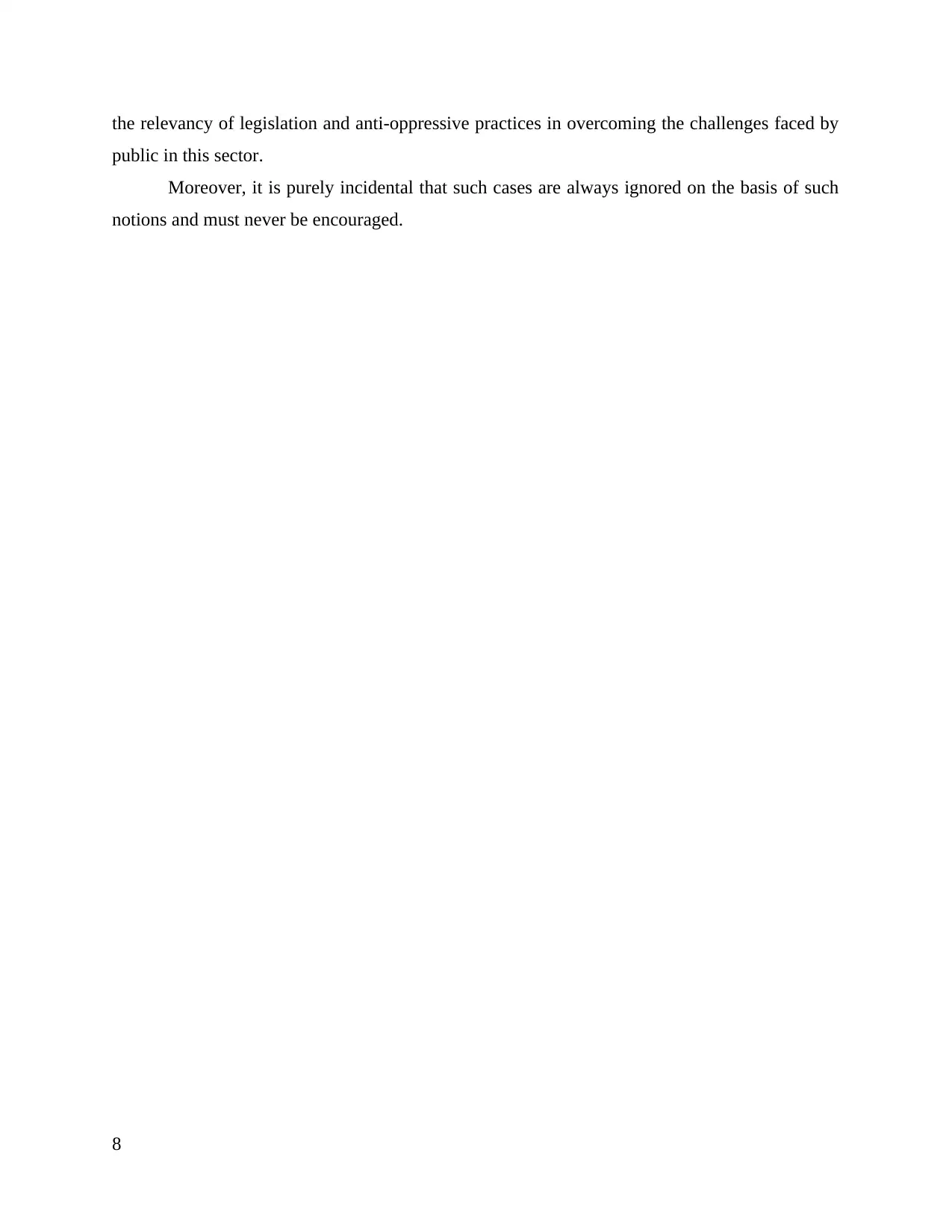
the relevancy of legislation and anti-oppressive practices in overcoming the challenges faced by
public in this sector.
Moreover, it is purely incidental that such cases are always ignored on the basis of such
notions and must never be encouraged.
8
public in this sector.
Moreover, it is purely incidental that such cases are always ignored on the basis of such
notions and must never be encouraged.
8
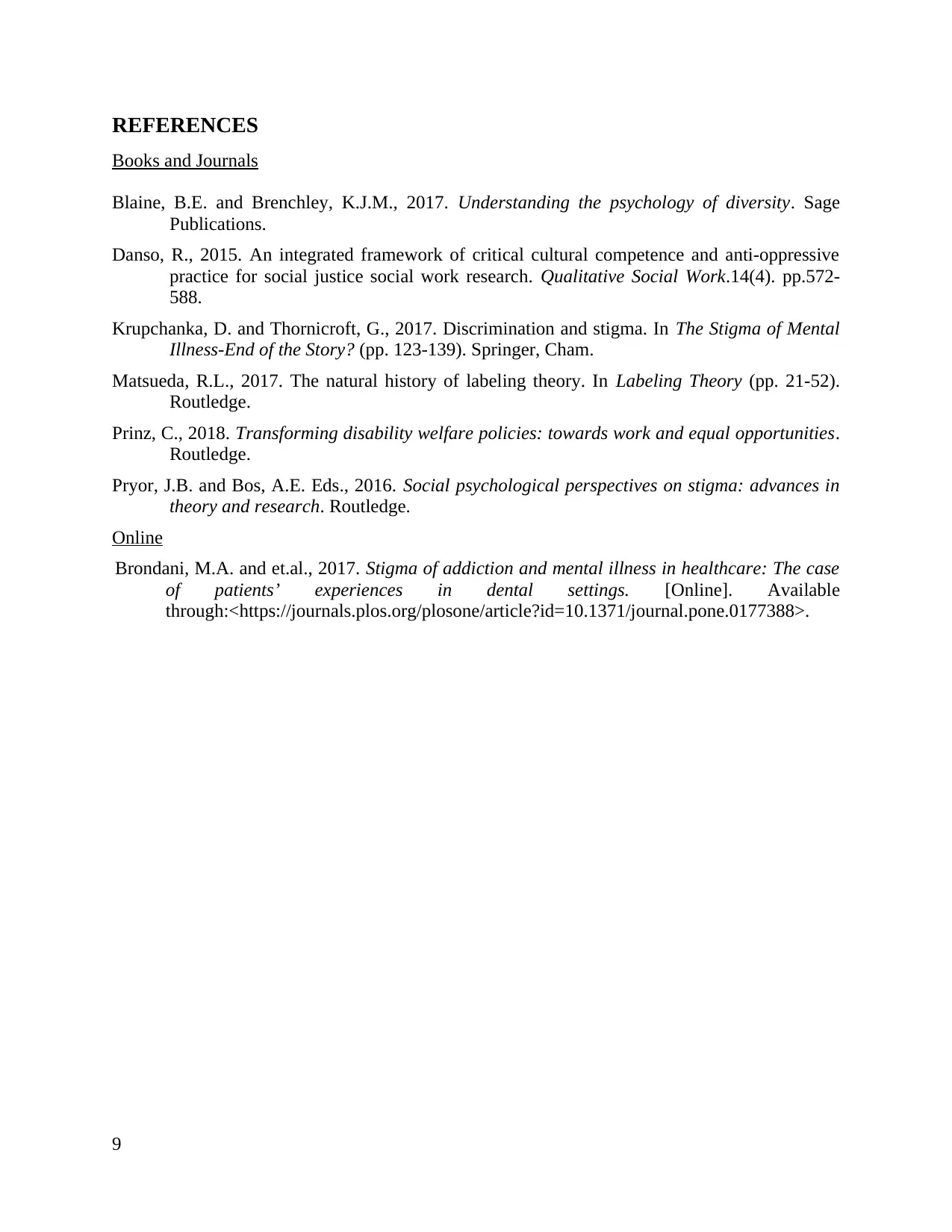
REFERENCES
Books and Journals
Blaine, B.E. and Brenchley, K.J.M., 2017. Understanding the psychology of diversity. Sage
Publications.
Danso, R., 2015. An integrated framework of critical cultural competence and anti-oppressive
practice for social justice social work research. Qualitative Social Work.14(4). pp.572-
588.
Krupchanka, D. and Thornicroft, G., 2017. Discrimination and stigma. In The Stigma of Mental
Illness-End of the Story? (pp. 123-139). Springer, Cham.
Matsueda, R.L., 2017. The natural history of labeling theory. In Labeling Theory (pp. 21-52).
Routledge.
Prinz, C., 2018. Transforming disability welfare policies: towards work and equal opportunities.
Routledge.
Pryor, J.B. and Bos, A.E. Eds., 2016. Social psychological perspectives on stigma: advances in
theory and research. Routledge.
Online
Brondani, M.A. and et.al., 2017. Stigma of addiction and mental illness in healthcare: The case
of patients’ experiences in dental settings. [Online]. Available
through:<https://journals.plos.org/plosone/article?id=10.1371/journal.pone.0177388>.
9
Books and Journals
Blaine, B.E. and Brenchley, K.J.M., 2017. Understanding the psychology of diversity. Sage
Publications.
Danso, R., 2015. An integrated framework of critical cultural competence and anti-oppressive
practice for social justice social work research. Qualitative Social Work.14(4). pp.572-
588.
Krupchanka, D. and Thornicroft, G., 2017. Discrimination and stigma. In The Stigma of Mental
Illness-End of the Story? (pp. 123-139). Springer, Cham.
Matsueda, R.L., 2017. The natural history of labeling theory. In Labeling Theory (pp. 21-52).
Routledge.
Prinz, C., 2018. Transforming disability welfare policies: towards work and equal opportunities.
Routledge.
Pryor, J.B. and Bos, A.E. Eds., 2016. Social psychological perspectives on stigma: advances in
theory and research. Routledge.
Online
Brondani, M.A. and et.al., 2017. Stigma of addiction and mental illness in healthcare: The case
of patients’ experiences in dental settings. [Online]. Available
through:<https://journals.plos.org/plosone/article?id=10.1371/journal.pone.0177388>.
9
⊘ This is a preview!⊘
Do you want full access?
Subscribe today to unlock all pages.

Trusted by 1+ million students worldwide
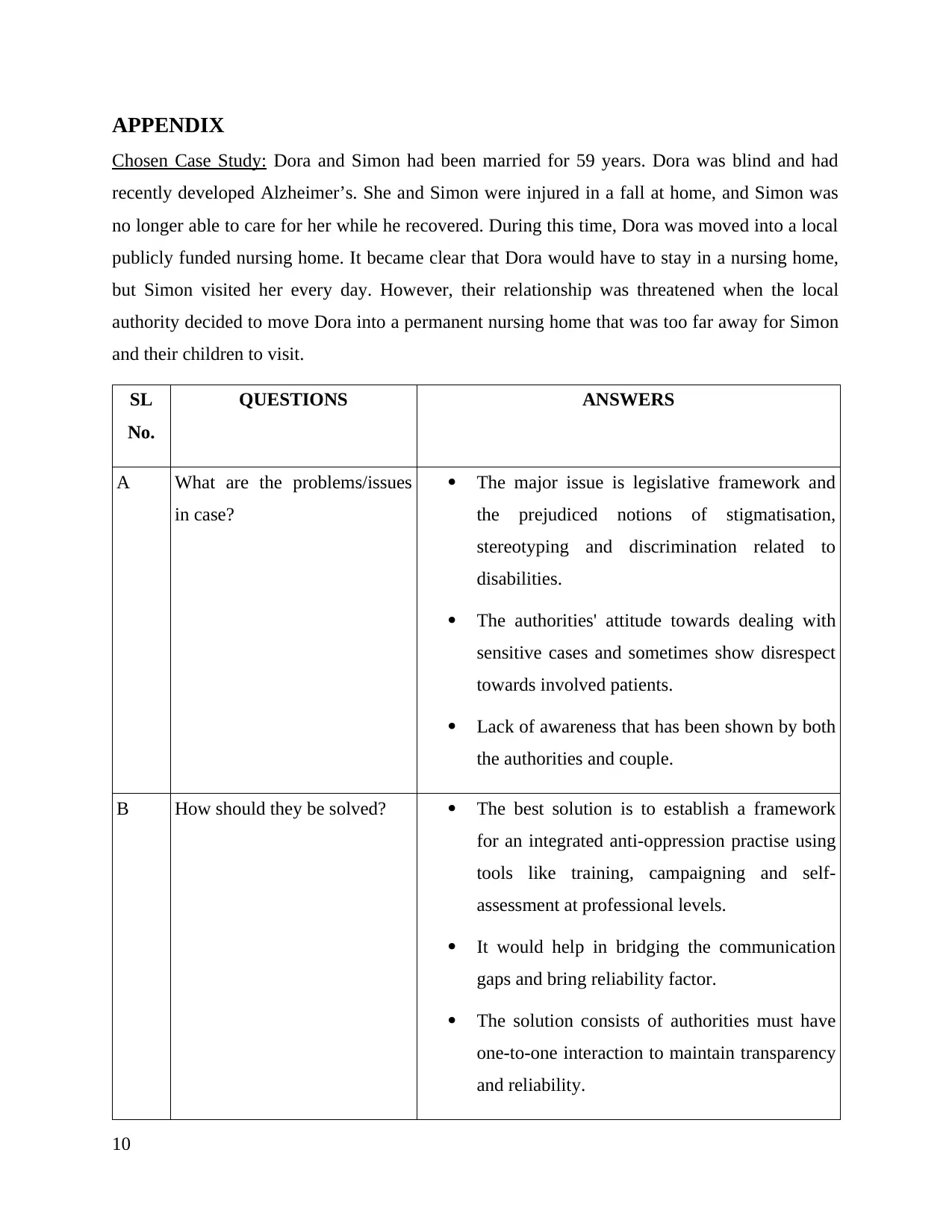
APPENDIX
Chosen Case Study: Dora and Simon had been married for 59 years. Dora was blind and had
recently developed Alzheimer’s. She and Simon were injured in a fall at home, and Simon was
no longer able to care for her while he recovered. During this time, Dora was moved into a local
publicly funded nursing home. It became clear that Dora would have to stay in a nursing home,
but Simon visited her every day. However, their relationship was threatened when the local
authority decided to move Dora into a permanent nursing home that was too far away for Simon
and their children to visit.
SL
No.
QUESTIONS ANSWERS
A What are the problems/issues
in case?
The major issue is legislative framework and
the prejudiced notions of stigmatisation,
stereotyping and discrimination related to
disabilities.
The authorities' attitude towards dealing with
sensitive cases and sometimes show disrespect
towards involved patients.
Lack of awareness that has been shown by both
the authorities and couple.
B How should they be solved? The best solution is to establish a framework
for an integrated anti-oppression practise using
tools like training, campaigning and self-
assessment at professional levels.
It would help in bridging the communication
gaps and bring reliability factor.
The solution consists of authorities must have
one-to-one interaction to maintain transparency
and reliability.
10
Chosen Case Study: Dora and Simon had been married for 59 years. Dora was blind and had
recently developed Alzheimer’s. She and Simon were injured in a fall at home, and Simon was
no longer able to care for her while he recovered. During this time, Dora was moved into a local
publicly funded nursing home. It became clear that Dora would have to stay in a nursing home,
but Simon visited her every day. However, their relationship was threatened when the local
authority decided to move Dora into a permanent nursing home that was too far away for Simon
and their children to visit.
SL
No.
QUESTIONS ANSWERS
A What are the problems/issues
in case?
The major issue is legislative framework and
the prejudiced notions of stigmatisation,
stereotyping and discrimination related to
disabilities.
The authorities' attitude towards dealing with
sensitive cases and sometimes show disrespect
towards involved patients.
Lack of awareness that has been shown by both
the authorities and couple.
B How should they be solved? The best solution is to establish a framework
for an integrated anti-oppression practise using
tools like training, campaigning and self-
assessment at professional levels.
It would help in bridging the communication
gaps and bring reliability factor.
The solution consists of authorities must have
one-to-one interaction to maintain transparency
and reliability.
10
Paraphrase This Document
Need a fresh take? Get an instant paraphrase of this document with our AI Paraphraser
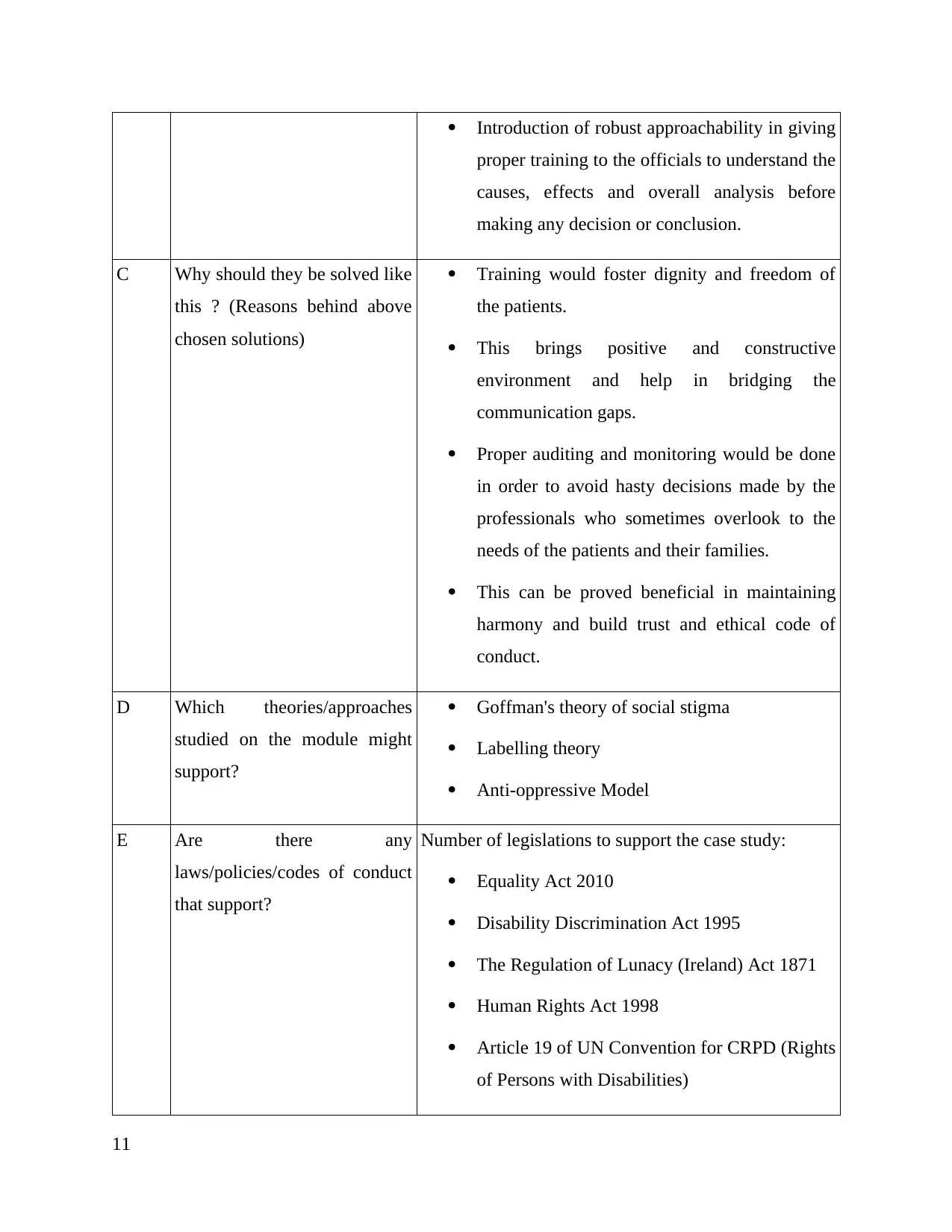
Introduction of robust approachability in giving
proper training to the officials to understand the
causes, effects and overall analysis before
making any decision or conclusion.
C Why should they be solved like
this ? (Reasons behind above
chosen solutions)
Training would foster dignity and freedom of
the patients.
This brings positive and constructive
environment and help in bridging the
communication gaps.
Proper auditing and monitoring would be done
in order to avoid hasty decisions made by the
professionals who sometimes overlook to the
needs of the patients and their families.
This can be proved beneficial in maintaining
harmony and build trust and ethical code of
conduct.
D Which theories/approaches
studied on the module might
support?
Goffman's theory of social stigma
Labelling theory
Anti-oppressive Model
E Are there any
laws/policies/codes of conduct
that support?
Number of legislations to support the case study:
Equality Act 2010
Disability Discrimination Act 1995
The Regulation of Lunacy (Ireland) Act 1871
Human Rights Act 1998
Article 19 of UN Convention for CRPD (Rights
of Persons with Disabilities)
11
proper training to the officials to understand the
causes, effects and overall analysis before
making any decision or conclusion.
C Why should they be solved like
this ? (Reasons behind above
chosen solutions)
Training would foster dignity and freedom of
the patients.
This brings positive and constructive
environment and help in bridging the
communication gaps.
Proper auditing and monitoring would be done
in order to avoid hasty decisions made by the
professionals who sometimes overlook to the
needs of the patients and their families.
This can be proved beneficial in maintaining
harmony and build trust and ethical code of
conduct.
D Which theories/approaches
studied on the module might
support?
Goffman's theory of social stigma
Labelling theory
Anti-oppressive Model
E Are there any
laws/policies/codes of conduct
that support?
Number of legislations to support the case study:
Equality Act 2010
Disability Discrimination Act 1995
The Regulation of Lunacy (Ireland) Act 1871
Human Rights Act 1998
Article 19 of UN Convention for CRPD (Rights
of Persons with Disabilities)
11
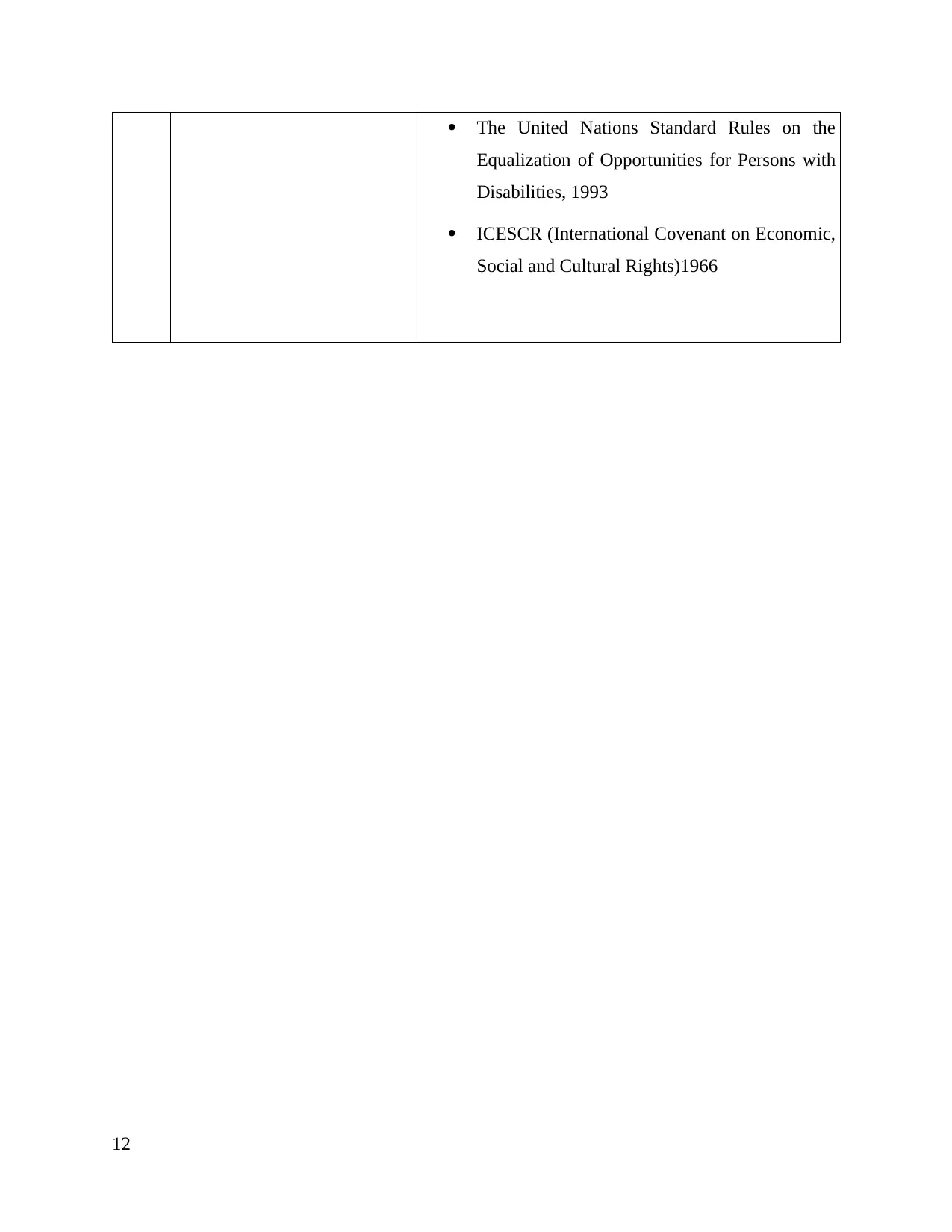
The United Nations Standard Rules on the
Equalization of Opportunities for Persons with
Disabilities, 1993
ICESCR (International Covenant on Economic,
Social and Cultural Rights)1966
12
Equalization of Opportunities for Persons with
Disabilities, 1993
ICESCR (International Covenant on Economic,
Social and Cultural Rights)1966
12
⊘ This is a preview!⊘
Do you want full access?
Subscribe today to unlock all pages.

Trusted by 1+ million students worldwide
1 out of 12
Related Documents
Your All-in-One AI-Powered Toolkit for Academic Success.
+13062052269
info@desklib.com
Available 24*7 on WhatsApp / Email
![[object Object]](/_next/static/media/star-bottom.7253800d.svg)
Unlock your academic potential
Copyright © 2020–2025 A2Z Services. All Rights Reserved. Developed and managed by ZUCOL.




